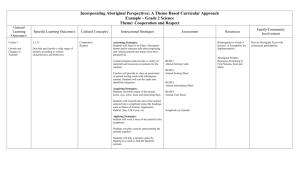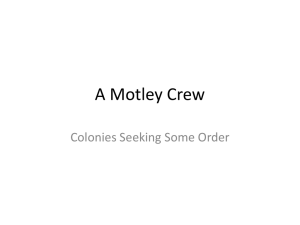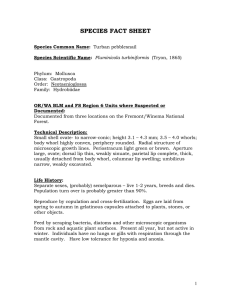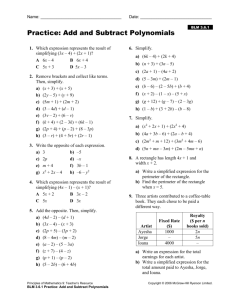Facilitating Backcountry Use of Bureau of Land Management Wildlands 1 R. Steve Smith
advertisement
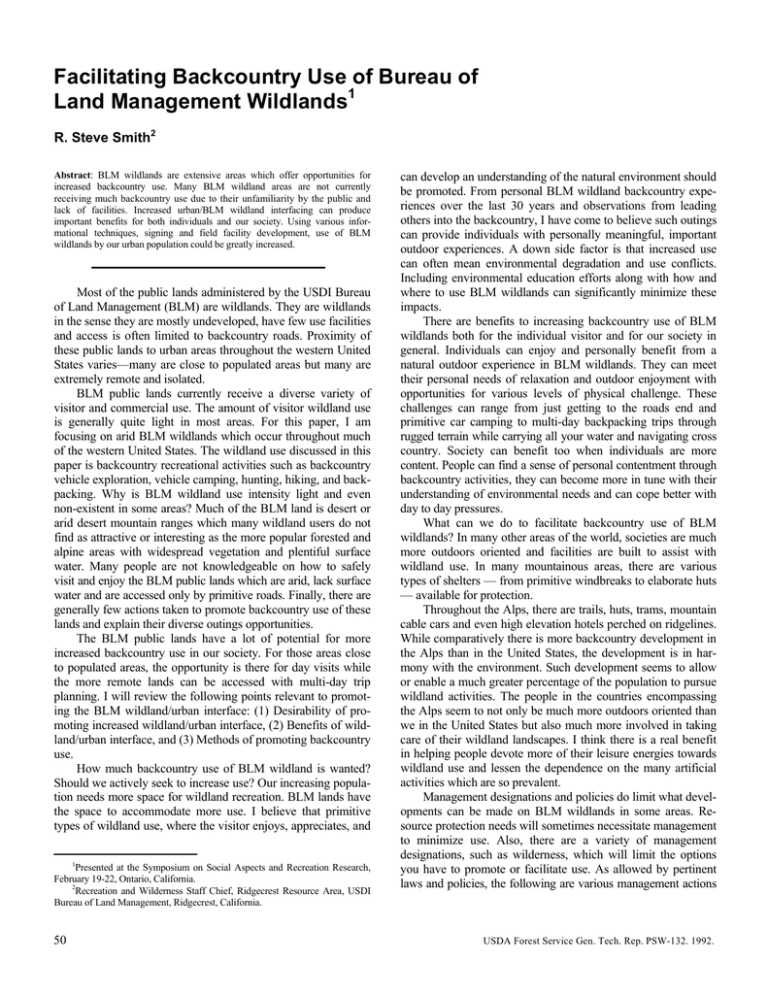
Facilitating Backcountry Use of Bureau of Land Management Wildlands1 R. Steve Smith2 Abstract: BLM wildlands are extensive areas which offer opportunities for increased backcountry use. Many BLM wildland areas are not currently receiving much backcountry use due to their unfamiliarity by the public and lack of facilities. Increased urban/BLM wildland interfacing can produce important benefits for both individuals and our society. Using various informational techniques, signing and field facility development, use of BLM wildlands by our urban population could be greatly increased. Most of the public lands administered by the USDI Bureau of Land Management (BLM) are wildlands. They are wildlands in the sense they are mostly undeveloped, have few use facilities and access is often limited to backcountry roads. Proximity of these public lands to urban areas throughout the western United States varies—many are close to populated areas but many are extremely remote and isolated. BLM public lands currently receive a diverse variety of visitor and commercial use. The amount of visitor wildland use is generally quite light in most areas. For this paper, I am focusing on arid BLM wildlands which occur throughout much of the western United States. The wildland use discussed in this paper is backcountry recreational activities such as backcountry vehicle exploration, vehicle camping, hunting, hiking, and backpacking. Why is BLM wildland use intensity light and even non-existent in some areas? Much of the BLM land is desert or arid desert mountain ranges which many wildland users do not find as attractive or interesting as the more popular forested and alpine areas with widespread vegetation and plentiful surface water. Many people are not knowledgeable on how to safely visit and enjoy the BLM public lands which are arid, lack surface water and are accessed only by primitive roads. Finally, there are generally few actions taken to promote backcountry use of these lands and explain their diverse outings opportunities. The BLM public lands have a lot of potential for more increased backcountry use in our society. For those areas close to populated areas, the opportunity is there for day visits while the more remote lands can be accessed with multi-day trip planning. I will review the following points relevant to promoting the BLM wildland/urban interface: (1) Desirability of promoting increased wildland/urban interface, (2) Benefits of wildland/urban interface, and (3) Methods of promoting backcountry use. How much backcountry use of BLM wildland is wanted? Should we actively seek to increase use? Our increasing population needs more space for wildland recreation. BLM lands have the space to accommodate more use. I believe that primitive types of wildland use, where the visitor enjoys, appreciates, and 1 Presented at the Symposium on Social Aspects and Recreation Research, February 19-22, Ontario, California. 2 Recreation and Wilderness Staff Chief, Ridgecrest Resource Area, USDI Bureau of Land Management, Ridgecrest, California. 50 can develop an understanding of the natural environment should be promoted. From personal BLM wildland backcountry experiences over the last 30 years and observations from leading others into the backcountry, I have come to believe such outings can provide individuals with personally meaningful, important outdoor experiences. A down side factor is that increased use can often mean environmental degradation and use conflicts. Including environmental education efforts along with how and where to use BLM wildlands can significantly minimize these impacts. There are benefits to increasing backcountry use of BLM wildlands both for the individual visitor and for our society in general. Individuals can enjoy and personally benefit from a natural outdoor experience in BLM wildlands. They can meet their personal needs of relaxation and outdoor enjoyment with opportunities for various levels of physical challenge. These challenges can range from just getting to the roads end and primitive car camping to multi-day backpacking trips through rugged terrain while carrying all your water and navigating cross country. Society can benefit too when individuals are more content. People can find a sense of personal contentment through backcountry activities, they can become more in tune with their understanding of environmental needs and can cope better with day to day pressures. What can we do to facilitate backcountry use of BLM wildlands? In many other areas of the world, societies are much more outdoors oriented and facilities are built to assist with wildland use. In many mountainous areas, there are various types of shelters — from primitive windbreaks to elaborate huts — available for protection. Throughout the Alps, there are trails, huts, trams, mountain cable cars and even high elevation hotels perched on ridgelines. While comparatively there is more backcountry development in the Alps than in the United States, the development is in harmony with the environment. Such development seems to allow or enable a much greater percentage of the population to pursue wildland activities. The people in the countries encompassing the Alps seem to not only be much more outdoors oriented than we in the United States but also much more involved in taking care of their wildland landscapes. I think there is a real benefit in helping people devote more of their leisure energies towards wildland use and lessen the dependence on the many artificial activities which are so prevalent. Management designations and policies do limit what developments can be made on BLM wildlands in some areas. Resource protection needs will sometimes necessitate management to minimize use. Also, there are a variety of management designations, such as wilderness, which will limit the options you have to promote or facilitate use. As allowed by pertinent laws and policies, the following are various management actions USDA Forest Service Gen. Tech. Rep. PSW-132. 1992. which can be considered for promoting backcountry use of BLM wildlands. Maps and Guides: Maps, brochures and guides could be developed to provide information on locating and accessing BLM wildland areas. Guides can be used to highlight opportunities for cross country travel where no trails exist and describe wildland natural and cultural features that would be of interest to visitors. Consider leaving or stabilizing features other than those with just historic value which can be of interest to backcountry users. In the Inyo Mountains a 26 ton bulldozer is abandoned at the remote Keynot mine at 8,400 feet and is now an oddity which attracts backpackers. Backcountry Use Methodology: Provide information on how BLM's arid and mountainous wildland areas can be safely used and techniques to follow to minimize environmental impacts. Water Sources and Developments: In most BLM wildlands areas, there are natural springs. Some already provide reliable water while others could be developed with minimal work to improve water collection and storage. It may be possible to put in artificial water catchments which could also be a source of water. Information on the location of these water sources and health aspects regarding purification needs could then be provided to users. Provide Shelters: In some areas, there are already historic cabins which can be stabilized and used for backcountry shelter. USDA Forest Service Gen. Tech. Rep. PSW-132. 1992. At other locations, various types of shelters could be developed, ranging from small windbreaks to more elaborate covered shelters. Friends of the Inyo Wilderness Study Area stabilized a historic cabin located at a remote site at 8,200 feet in the Inyo Mountains and stocked it with emergency provisions. Preliminary results show knowledge of this cabin has generated more use and no added management problems. Trails: There are many historic trails not actively used which could be easily improved for current use. New trails could be developed and kept at a lower standard of construction to keep down costs and lessen environmental impacts. Signing: Install signs which provide directions and show trail routes. Conduct Orientation Trips: Experienced personnel could schedule and lead wildland outings of varying degrees of difficulty. Such trips would then enable visitors to learn about backcountry opportunities, use procedures and enable them to return for follow up outings. Establish Trailheads: A major need for use of BLM wildlands are access points which can be located and accessed. Mark Cross Country Routes: Many BLM wildlands have outstanding opportunities for day hikes and backpack trips where no type of use trail exists. Route marking techniques using rock cairns and signing could be used to help visitors negotiate cross country travel routes. 51

